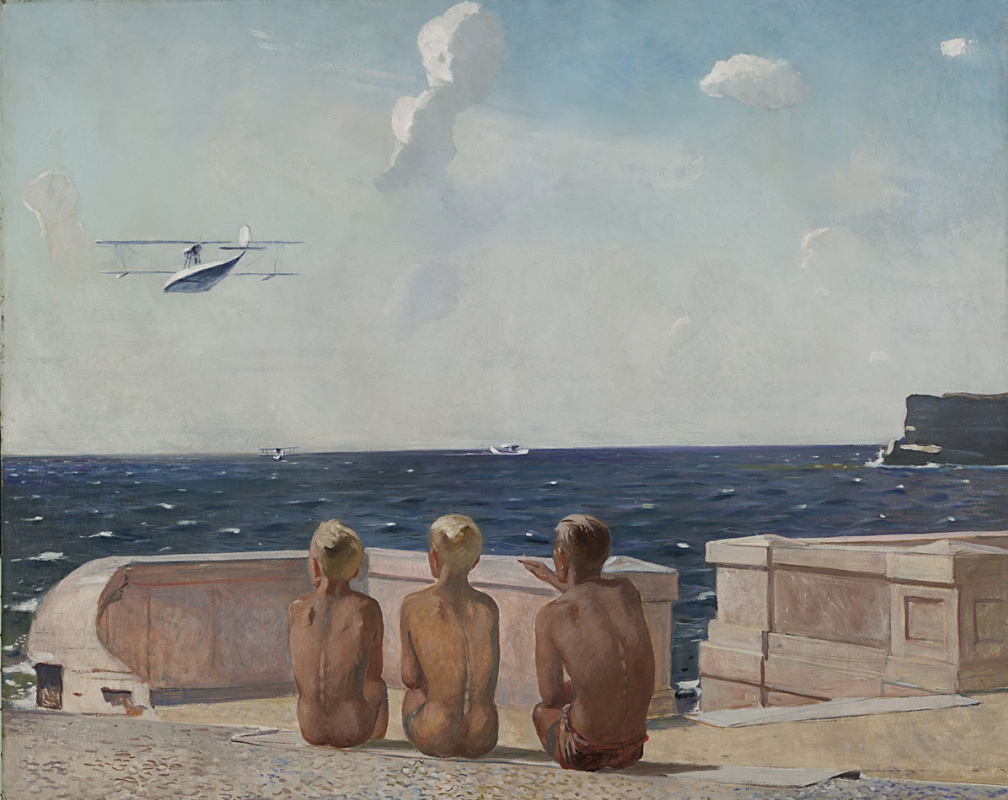log in
Enter site
Login to use Arthive functionality to the maximum
Future pilots
Alexander Alexandrovich Deineka • Pintura, 1938, 131×161 cm
Descripción del cuadro «Future pilots»
"Future pilots" one of the most famous works as Alexander Deineka and overall direction, referred to as socialist realism. It perfectly matched the inherent realism of the expectation of a bright future, and the perceived light of the present, and lyricism, great warmth, intimacy. The picture is completely devoid of officialdom, which killed socialist realism as a direction. Her charm allowed "Future pilots" almost immediately become popular with the public.
Crimean landscape – rich, written with a thick color of the sea, high, almost cloudless sky, flying a seaplane – and three tanned boys. The guys pictured from the back, their faces we cannot see, but I can easily imagine how delighted sparkle in their eyes that the younger listen to the older boy, the one on the right. It seems that even their thin backs with protruding vertebrae Express the highest degree of interest. The older boy, probably 13-15 years. He's dressed in swimming trunks or shorts, the younger sitting naked on a bed. Clearly felt the heat of the sun-warmed stones of the embankment. The painting is a bit of an angle, we look like from behind the guys, and the opinion pieces in one line of boys, line of the horizon and the plane.
Alexander Deineka loved everything associated with aviation, and in the bays of Sevastopol certainly admired rising to the sky machine. He talked a lot with pilots. The picture was first presented to the public in a dedicated aviation section at the exhibition in honor of the 20th anniversary of the worker-peasant red Army and Navy (1938).
We have a case where the title makes the picture. Call it "Youth" or "Summer in Sevastopol," or "by the sea" – and half of the meaning is immediately lost. Remains a domestic story, childhood, youth, summer-sea. The name "Future pilots" introduces a note of hope, belief in a bright future and light sweet smile. Perhaps it is because of this name, creating a certain context, the picture is so charming. By the way, give the artist otherwise there would be no reason to classify it to socialist realism, would have been just a conversation piece, episode in the life of the children and the sea. And her fate would have been different, and would it, by and large, a very different picture.
The mood of the painting is very joyous, major. There is no reason to hide that Deineka was sincerely shared revolutionary views and believed in the Soviet future. The best thing about this special sense of joy and open opportunities that are transferred to many of his works, he himself said: "the Picture of modernity – the dream of bright children's sleep, which can be within the framework of the reality of her photographs. Because this is tales and tales of the proletariat, creating your colorful life". Tales, as we know, was not as happy as I would like, but paintings of Deineka therefore Shine and radiate the joy and optimism he wrote a vivid dream, in which he believed.
Author: Alain Grosheva
Crimean landscape – rich, written with a thick color of the sea, high, almost cloudless sky, flying a seaplane – and three tanned boys. The guys pictured from the back, their faces we cannot see, but I can easily imagine how delighted sparkle in their eyes that the younger listen to the older boy, the one on the right. It seems that even their thin backs with protruding vertebrae Express the highest degree of interest. The older boy, probably 13-15 years. He's dressed in swimming trunks or shorts, the younger sitting naked on a bed. Clearly felt the heat of the sun-warmed stones of the embankment. The painting is a bit of an angle, we look like from behind the guys, and the opinion pieces in one line of boys, line of the horizon and the plane.
Alexander Deineka loved everything associated with aviation, and in the bays of Sevastopol certainly admired rising to the sky machine. He talked a lot with pilots. The picture was first presented to the public in a dedicated aviation section at the exhibition in honor of the 20th anniversary of the worker-peasant red Army and Navy (1938).
We have a case where the title makes the picture. Call it "Youth" or "Summer in Sevastopol," or "by the sea" – and half of the meaning is immediately lost. Remains a domestic story, childhood, youth, summer-sea. The name "Future pilots" introduces a note of hope, belief in a bright future and light sweet smile. Perhaps it is because of this name, creating a certain context, the picture is so charming. By the way, give the artist otherwise there would be no reason to classify it to socialist realism, would have been just a conversation piece, episode in the life of the children and the sea. And her fate would have been different, and would it, by and large, a very different picture.
The mood of the painting is very joyous, major. There is no reason to hide that Deineka was sincerely shared revolutionary views and believed in the Soviet future. The best thing about this special sense of joy and open opportunities that are transferred to many of his works, he himself said: "the Picture of modernity – the dream of bright children's sleep, which can be within the framework of the reality of her photographs. Because this is tales and tales of the proletariat, creating your colorful life". Tales, as we know, was not as happy as I would like, but paintings of Deineka therefore Shine and radiate the joy and optimism he wrote a vivid dream, in which he believed.
Author: Alain Grosheva



